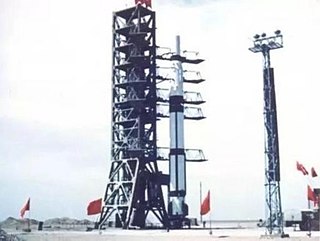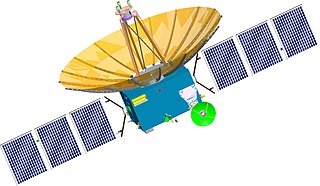Related Research Articles

The space program of the People's Republic of China is about the activities in outer space conducted and directed by the People's Republic of China. The roots of the Chinese space program trace back to the 1950s, when, with the help of the newly allied Soviet Union, China began development of its first ballistic missile and rocket programs in response to the perceived American threats. Driven by the successes of Soviet Sputnik 1 and American Explorer 1 satellite launches in 1957 and 1958 respectively, China would launch its first satellite, Dong Fang Hong 1 in April 1970 aboard a Long March 1 rocket, making it the fifth nation to place a satellite in orbit.

The Xichang Satellite Launch Center (XSLC), also known as the Xichang Space Center, is a spaceport in China. It is located in Zeyuan Town (泽远镇), approximately 64 kilometers (40 mi) northwest of Xichang, Liangshan Yi Autonomous Prefecture in Sichuan.

The Chinese Lunar Exploration Program, also known as the Chang'e Project after the Chinese Moon goddess Chang'e, is an ongoing series of robotic Moon missions by the China National Space Administration (CNSA).

The following outline is provided as an overview of and topical guide to space exploration.

In orbital mechanics, a Lissajous orbit, named after Jules Antoine Lissajous, is a quasi-periodic orbital trajectory that an object can follow around a Lagrangian point of a three-body system with minimal propulsion. Lyapunov orbits around a Lagrangian point are curved paths that lie entirely in the plane of the two primary bodies. In contrast, Lissajous orbits include components in this plane and perpendicular to it, and follow a Lissajous curve. Halo orbits also include components perpendicular to the plane, but they are periodic, while Lissajous orbits are usually not.

Chang'e 2 is a Chinese uncrewed lunar probe that was launched on 1 October 2010. It was a follow-up to the Chang'e 1 lunar probe, which was launched in 2007. Chang'e 2 was part of the first phase of the Chinese Lunar Exploration Program, and conducted research from a 100-km-high lunar orbit in preparation for the December 2013 soft landing by the Chang'e 3 lander and rover. Chang'e 2 was similar in design to Chang'e 1, although it featured some technical improvements, including a more advanced onboard camera. Like its predecessor, the probe was named after Chang'e, an ancient Chinese moon goddess.

This article documents notable spaceflight events during the year 2018. For the first time since 1990, more than 100 orbital launches were performed globally.

Chang'e 4 is a robotic spacecraft mission in the Chinese Lunar Exploration Program of the CNSA. China achieved humanity's first soft landing on the far side of the Moon with its touchdown on 3 January 2019.

The Tianzhou is a Chinese automated cargo spacecraft developed from China's first prototype space station Tiangong-1 to resupply its modular space station. It was first launched on the Long March 7 rocket from Wenchang on April 20, 2017 and demonstrated autonomous propellant transfer.

This article documents notable spaceflight events during the year 2020.

The year 2024 is expected to exceed 2023's 223 orbital launches. So far, the year saw the successful first launch of Vulcan Centaur, Gravity-1, Ariane 6, and notably more developmental launches of SpaceX's Starship – with IFT-3, IFT-4, IFT-5, and IFT-6 planned for this year. Additionally, the final launch of a Delta family rocket occurred in April with a Delta IV Heavy. In May, China launched the Chang'e 6, the first sample return from the far side of the Moon.
Tianwen-2 is a planned Chinese asteroid sample return and comet exploration mission that is currently under development. Tianwen-2 was originally known as ZhengHe.

Queqiao relay satellite (Chinese: 鹊桥号中继卫星; pinyin: Quèqiáo hào zhōngjì wèixīng; lit. 'Magpie Bridge relay satellite'), is the first of the pair of communications relay and radio astronomy satellites for the Chinese Lunar Exploration Program. The China National Space Administration (CNSA) launched the Queqiao relay satellite on 20 May 2018 to a halo orbit around the Earth–Moon L2 Lagrangian point Queqiao is the first ever communication relay and radio astronomy satellite at this location.
Tianlian also known as CTDRS, is a Chinese data relay communication satellite constellation. The constellation serves to relay data from ground stations to spacecraft and rockets, most significantly China's crewed spaceflight program. The system currently consists of seven satellites in two generations, with the first satellite being launched in 2008.

Queqiao-2 relay satellite, is the second communications relay and radio astronomy satellites designed to support the fourth phase the Chinese Lunar Exploration Program, after Queqiao-1 launched in 2018. The China National Space Administration (CNSA) launched the Queqiao-2 relay satellite on 20 March 2024 to an elliptical frozen orbit around the Moon to support communications from the far side of the Moon and the Lunar south pole.

ICUBE-Q or ICUBE-QAMAR is a Pakistani lunar remote sensing observation nanosatellite and is one of the four international payloads of the Chang'e 6 lunar sample-return mission. It is a joint venture between the Institute of Space Technology (IST), Space & Upper Atmosphere Research Commission (SUPARCO) and the Intelligent Satellite Technology Center of Shanghai Jiao Tong University (SJTU), under the framework of Asia-Pacific Space Cooperation Organization (APSCO). It is the first deep space mission of Pakistan.
References
- ↑ "China launches Queqiao-2 relay satellite to support moon missions". Space.com. Retrieved 20 March 2024.
- ↑ "China launches Queqiao-2 relay satellite to support moon missions". Space.com. Retrieved 20 March 2024.
- ↑ "China launches Queqiao-2 relay satellite to support moon missions". Space.com. Retrieved 20 March 2024.
- ↑ Jones, Andrew (2024-03-25). "China's Queqiao-2 relay satellite enters lunar orbit". SpaceNews. Retrieved 2024-03-26.
- 1 2 3 4 5 "Tiandu 1, 2". Gunter's Space Page. Retrieved 2024-03-23.
- 1 2 3 4 Jones, Andrew (10 May 2023). "China to launch communications relay satellite to the moon in early 2024". Space.com.
- ↑ Andrew Jones (2023-05-09). "China to launch communications relay satellite to the moon in early 2024". Space.com. Retrieved 2024-03-23.
- ↑ "MSN". www.msn.com. Retrieved 2024-03-23.
- ↑ "Testing, testing … China to test new satellite tech for Chang'e 6 lunar mission". South China Morning Post. 2024-02-04. Retrieved 2024-03-23.
- ↑ Litvinov, Nikita (2024-02-08). "China will launch experimental satellites to the Moon". Журнал The Universemagazine Space Tech. Retrieved 2024-03-23.
- ↑ 郭凯. "China set to launch two experimental satellites". www.chinadaily.com.cn. Retrieved 2024-03-23.
- ↑ "China launches Queqiao-2 as key relay communication platform for future lunar missions - China Military". eng.chinamil.com.cn. Retrieved 2024-03-23.
- ↑ Jones, Andrew (2024-03-25). "China's Queqiao-2 relay satellite enters lunar orbit". SpaceNews. Retrieved 2024-03-26.
- ↑ "探月工程里程碑:天都二号卫星成功应用冷气微推进系统". Weixin Official Accounts Platform. Retrieved 2024-04-04.
- ↑ "我国将发射"天都一号""天都二号"探月卫星-新华网". www.news.cn. Retrieved 2024-03-20.
- ↑ Andrew Jones (2022-03-31). "China has big plans for its new Tiandu space exploration laboratory". Space.com. Retrieved 2024-03-23.
